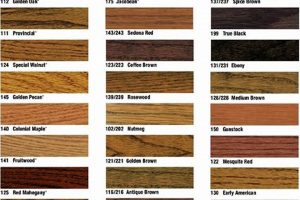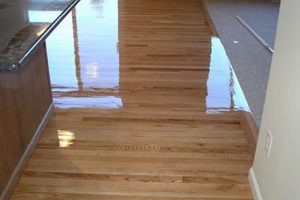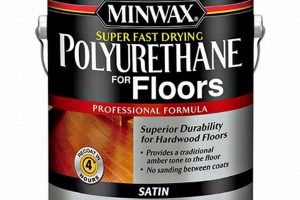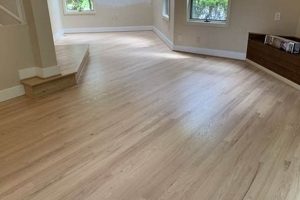The application of treatments to a concrete surface to enhance its appearance, durability, and functionality is a crucial aspect of construction. This process encompasses a variety of techniques designed to alter the concrete’s texture, color, and protective qualities. For example, polishing can create a smooth, reflective surface, while staining can impart a desired color or pattern.
Properly executed surface treatments offer numerous advantages. They can increase resistance to abrasion, chemicals, and staining, thereby extending the lifespan of the floor. Furthermore, these techniques can significantly improve aesthetics, transforming a utilitarian slab into a visually appealing element of the interior design. Historically, simpler methods like sealing were employed primarily for protection, but modern advancements have broadened the scope to include complex decorative possibilities.
The following sections will delve into specific techniques, material choices, and best practices involved in achieving optimal results for a concrete surface. These include considerations for preparation, application methods, and long-term maintenance strategies, ensuring a robust and aesthetically pleasing final product.
Guidance on Concrete Surface Refinement
This section provides essential guidance for achieving optimal outcomes during refinement of concrete surfaces. Adherence to these recommendations will contribute to both durability and aesthetic quality.
Tip 1: Surface Preparation is Paramount: Before any treatment, ensure the concrete is clean, dry, and free of contaminants. This may involve grinding, shot blasting, or chemical cleaning to promote proper adhesion.
Tip 2: Select Appropriate Materials: The choice of sealant, stain, or coating should be dictated by the intended use of the floor and the desired aesthetic. Consider factors such as traffic volume, chemical exposure, and UV resistance.
Tip 3: Adhere to Manufacturer Instructions: Diligently follow the manufacturer’s guidelines for mixing, application, and curing times. Deviations can lead to premature failure or undesirable results.
Tip 4: Control Environmental Conditions: Temperature and humidity levels can significantly impact the curing process. Ensure that the environment is within the recommended range during application and curing.
Tip 5: Multiple Thin Coats are Preferable: When applying coatings or sealants, multiple thin coats generally provide better adhesion and a more uniform appearance than a single thick coat.
Tip 6: Test in an Inconspicuous Area: Before applying any treatment to the entire floor, test it in a small, less visible area to ensure the desired color, texture, and performance are achieved.
Tip 7: Proper Curing is Essential: Adequate curing is crucial for the development of strength and durability. Follow the manufacturer’s recommendations for curing time and methods.
Tip 8: Regular Maintenance is Required: Once the process is complete, implement a regular maintenance schedule that includes cleaning and periodic reapplication of sealants or coatings to prolong the life of the surface.
By implementing these tips, stakeholders can maximize the lifespan and visual appeal of concrete surfaces. The appropriate selection of materials, meticulous preparation, and strict adherence to application guidelines are the cornerstones of success.
The concluding section will summarize the key considerations for a successful project and offer insights into troubleshooting common issues.
1. Preparation crucial
The success of any concrete surface refinement project is inextricably linked to the initial preparatory steps. Inadequate preparation directly undermines the integrity and aesthetics of the subsequent finishing layers. Contaminants such as dust, oil, or existing coatings hinder proper adhesion, leading to premature failure of the applied treatment. For instance, attempting to apply a stain or epoxy coating to a concrete surface that has not been properly cleaned and profiled will invariably result in delamination, blistering, or uneven coloration. This necessitates costly repairs and rework, highlighting the direct correlation between meticulous preparation and a durable, aesthetically pleasing final product.
The preparation phase typically involves several critical steps. These include thorough cleaning to remove surface contaminants, mechanical profiling to create a textured surface that enhances adhesion, and crack or damage repair to ensure a uniform substrate. Depending on the existing condition of the concrete, techniques such as grinding, shot blasting, or acid etching may be employed. Each method serves to create an optimal surface for receiving the intended treatment. Ignoring any of these steps compromises the entire undertaking, no matter how sophisticated the finishing products or techniques used. An example is when applying a self-leveling overlay, neglecting to properly prime the existing surface will result in the overlay failing to bond correctly, leading to cracking and crumbling.
In summary, proper preparation is not merely a preliminary step; it forms the very foundation of a successful concrete surface treatment. Its omission invariably leads to compromised durability, increased maintenance costs, and unsatisfactory aesthetic results. The investment in thorough and appropriate preparatory measures translates directly into a longer lifespan, enhanced performance, and improved appearance of the finalized surface, underscoring its irrefutable importance within the larger framework of concrete surface modification.
2. Material selection
The efficacy and longevity of any concrete surface treatment are intrinsically linked to the selection of appropriate materials. The chosen substances directly determine the floor’s resistance to wear, chemical exposure, and staining, as well as its overall aesthetic. The cause-and-effect relationship is evident: selecting an incompatible or substandard sealant will invariably lead to premature degradation, requiring frequent repairs or complete replacement. Consider, for example, a high-traffic commercial space where an inexpensive, water-based acrylic sealant is applied. Such a sealant, while initially cost-effective, will quickly succumb to abrasion and staining from foot traffic and spills, ultimately proving more expensive due to the need for frequent reapplication. Conversely, a more robust polyurethane or epoxy coating, though initially more costly, offers superior durability and chemical resistance, leading to lower long-term maintenance expenses and a longer service life.
The practical significance of understanding the interplay between material properties and application environment is considerable. In industrial settings, where floors are frequently exposed to harsh chemicals and heavy machinery, the selection of chemical-resistant epoxy or novolac coatings is paramount. These coatings provide a protective barrier, preventing corrosion and degradation of the underlying concrete. Similarly, in residential applications, the choice of stain or dye affects the aesthetic outcome and influences the floor’s resistance to UV fading and staining. Water-based stains are often preferred for their low VOC content and ease of application, while acid stains offer a more permanent, mottled appearance. The decision-making process must consider the specific demands of the environment, the desired aesthetic, and the long-term maintenance requirements.
In conclusion, the selection of materials is a critical component of concrete surface treatment, directly impacting the floor’s durability, aesthetic appeal, and long-term maintenance costs. While challenges may arise in balancing initial cost with long-term performance, a thorough understanding of material properties and application requirements is essential for achieving optimal results. Failing to prioritize appropriate material selection ultimately compromises the entire project, underscoring its central role in the broader goal of enhancing and protecting concrete surfaces.
3. Application technique
The method employed in applying concrete surface treatments exerts a substantial influence on the final product’s performance and aesthetic quality. Variance in technique can lead to inconsistencies in color, texture, and durability, ultimately affecting the long-term viability of the floor.
- Even Distribution
Uniform application is paramount for achieving consistent results. Uneven distribution of sealants, coatings, or stains can lead to variations in color intensity, gloss levels, and protective properties. For instance, pooling of sealant in low spots results in a thicker layer that may cure differently, leading to discoloration or cracking, while areas with insufficient sealant may be more susceptible to wear and staining.
- Proper Equipment
The selection of appropriate application equipment is critical for optimal results. Using the wrong tools can compromise the quality of the finish. For example, applying a coating with an incorrect nozzle size on a sprayer can cause uneven coverage and orange peel texture. Similarly, using a low-quality roller can leave behind fibers and imperfections in the finish.
- Environmental Control
Ambient conditions during application play a significant role in the curing process and final appearance. Temperature, humidity, and airflow affect the rate at which sealants and coatings dry and harden. Applying a coating in high humidity can lead to blistering or clouding, while applying a sealant in direct sunlight can cause it to cure too quickly, resulting in cracking or poor adhesion.
- Layer Thickness
Maintaining the correct layer thickness is essential for achieving the desired performance characteristics. Applying a coating too thinly can compromise its protective properties, while applying it too thickly can lead to cracking or bubbling. Manufacturer specifications typically provide guidelines for the optimal layer thickness for each product, and adherence to these guidelines is crucial for ensuring a durable and long-lasting finish.
These facets highlight the nuanced relationship between application and outcome. Consistent, controlled methods are required to optimize the aesthetic and functional benefits of any concrete surface enhancement. Deviations from recommended practices result in compromised results, impacting both visual appeal and structural integrity. The interplay between skill, equipment, and environment underscores the importance of trained professionals and adherence to best practice guidelines during the application phase of concrete surface treatment.
4. Curing process
The curing process is integral to the successful execution of concrete floor finishing. It directly influences the strength, durability, and long-term performance of the finished surface. Proper curing ensures the concrete achieves its designed properties, allowing it to withstand anticipated loads and environmental stressors.
- Hydration Management
Curing controls the rate of hydration, the chemical reaction between cement and water that forms the concrete matrix. Premature drying prevents complete hydration, leading to weaker, more porous concrete. For example, rapid evaporation in hot, windy conditions can cause surface cracking and dusting. Effective curing methods, such as water ponding or the application of curing compounds, maintain moisture levels and promote optimal hydration throughout the concrete mass.
- Strength Development
The curing process directly influences the concrete’s compressive and flexural strength. Adequate curing allows the cement paste to fully hydrate, resulting in a denser, stronger material. Insufficient curing compromises strength development, making the floor more susceptible to cracking, spalling, and other forms of damage. This is particularly critical in industrial floors subjected to heavy loads and abrasive forces.
- Volume Stability
Proper curing minimizes volume changes in concrete, reducing the risk of shrinkage cracking. As concrete hydrates, it undergoes a certain amount of shrinkage. Controlled curing reduces the rate of evaporation, allowing the concrete to shrink more uniformly and minimizing stress concentrations that lead to cracking. This is especially important in large, monolithic floor slabs.
- Surface Quality
The curing process affects the surface quality of the finished floor. Proper curing results in a harder, more durable surface that is resistant to abrasion, staining, and dusting. Conversely, inadequate curing can lead to a soft, chalky surface that is easily damaged. Surface treatments, such as sealers and coatings, adhere more effectively to properly cured concrete, enhancing their performance and longevity.
The aforementioned facets highlight the pivotal role of curing in realizing the full potential of concrete floor finishing. Effective curing practices not only enhance the structural integrity and durability of the floor but also contribute to its long-term aesthetic appeal and serviceability. By controlling hydration, maximizing strength development, promoting volume stability, and enhancing surface quality, the curing process lays the foundation for a successful and enduring concrete floor.
5. Sealing necessity
The application of a sealing agent represents a critical and often indispensable step in concrete floor finishing. The decision to seal directly impacts the floor’s resistance to environmental factors, its ease of maintenance, and its long-term aesthetic appeal. Omitting this process can lead to premature degradation and increased maintenance requirements.
- Protection Against Staining
Unsealed concrete is porous and readily absorbs liquids, leading to staining from spills of oil, grease, wine, or other common substances. This can permanently mar the appearance of the floor and require aggressive cleaning methods that may further damage the surface. A sealant creates a barrier that prevents liquids from penetrating the concrete, simplifying cleanup and preserving the floor’s appearance. For example, a polished concrete floor in a restaurant would be highly susceptible to staining from food and beverage spills if not adequately sealed.
- Resistance to Abrasion
Concrete floors are subject to abrasion from foot traffic, vehicular movement, and the dragging of objects. Unsealed concrete is more vulnerable to surface wear and dusting, resulting in a loss of sheen and the release of fine particles into the air. A sealant provides a protective layer that resists abrasion, extending the life of the floor and reducing the need for costly repairs or refinishing. Consider a warehouse environment where forklift traffic would quickly degrade an unsealed concrete floor, creating dust and requiring frequent maintenance.
- Enhancement of Chemical Resistance
In industrial or commercial settings, concrete floors may be exposed to a variety of chemicals, including acids, alkalis, and solvents. These chemicals can corrode and degrade unsealed concrete, leading to structural damage and safety hazards. A chemical-resistant sealant provides a barrier that protects the concrete from chemical attack, ensuring its long-term integrity. For instance, a concrete floor in a chemical processing plant would require a specialized sealant to withstand exposure to corrosive substances.
- Simplified Maintenance
Sealed concrete floors are easier to clean and maintain than unsealed floors. The smooth, non-porous surface created by the sealant prevents dirt and grime from penetrating the concrete, allowing for easy removal with simple cleaning methods. This reduces the need for harsh chemicals or abrasive cleaning techniques that can damage the floor. A sealed concrete floor in a retail store, for example, can be quickly and easily cleaned, maintaining a clean and presentable appearance with minimal effort.
The selection of an appropriate sealant must consider the specific demands of the environment and the desired performance characteristics. Factors such as traffic volume, chemical exposure, and aesthetic requirements should guide the choice of sealant type and application method. Ultimately, sealing is an essential investment that protects the floor, extends its lifespan, and enhances its aesthetic appeal, underscoring its significance in concrete floor finishing.
6. Maintenance schedule
A structured maintenance schedule is not merely an ancillary consideration but a fundamental component of concrete floor finishing. The long-term performance and aesthetic appeal of a finished concrete floor are inextricably linked to the implementation and consistent adherence to a well-defined maintenance plan. This schedule acts as a preventative measure, safeguarding the initial investment and mitigating the need for costly restorative actions.
- Regular Cleaning Protocols
The establishment of routine cleaning procedures is paramount for preserving the surface integrity of finished concrete. These protocols should specify appropriate cleaning agents and methods, tailored to the type of sealant or coating applied. For instance, the accumulation of dirt and grime on a polished concrete floor can dull its luster and increase the likelihood of abrasion under foot traffic. Regularly scheduled cleaning with neutral pH cleaners can prevent this buildup, maintaining the floor’s reflectivity and minimizing wear. In contrast, using harsh chemicals or abrasive cleaners can compromise the sealant, leading to staining, scratching, or even complete sealant failure.
- Periodic Inspection and Assessment
Regular inspections are essential for identifying potential problems before they escalate into significant issues. These assessments should include a visual examination for cracks, chips, stains, and areas of wear or delamination. Early detection allows for timely repairs, preventing further damage and extending the floor’s lifespan. As an example, noticing minor surface cracks in a warehouse floor allows for prompt sealing with appropriate crack fillers, preventing water penetration and subsequent structural damage caused by freeze-thaw cycles.
- Reapplication of Protective Coatings
Protective coatings, such as sealants or waxes, inevitably degrade over time due to wear and environmental exposure. The maintenance schedule should include provisions for the periodic reapplication of these coatings to maintain their protective properties. The frequency of reapplication will depend on the traffic volume, the type of coating, and the environmental conditions. A retail store, with high foot traffic, will require more frequent resealing than a residential garage. Failure to reapply coatings can result in increased susceptibility to staining, abrasion, and chemical damage.
- Prompt Spill Response
A well-defined spill response protocol is crucial for preventing permanent damage to finished concrete floors. Spills of corrosive substances, oils, or staining agents should be cleaned up immediately using appropriate cleaning methods. Delaying the cleanup can allow the substance to penetrate the sealant and stain the concrete, necessitating more extensive cleaning or even refinishing. This protocol should include readily available spill cleanup kits with appropriate absorbent materials and cleaning solutions, ensuring quick and effective response to accidental spills.
In conclusion, the facets of a maintenance schedule detailed above are not isolated tasks but rather interwoven elements that collectively contribute to the preservation and enhancement of concrete floor finishing. A meticulously crafted and consistently executed maintenance plan is a crucial investment, safeguarding the floor’s integrity, extending its lifespan, and ensuring its enduring aesthetic appeal within diverse environments.
7. Durability enhancement
The extension of a concrete floor’s lifespan and its capacity to withstand applied stresses are paramount considerations in construction. Durability enhancement, in the context of concrete floor finishing, refers to specific interventions designed to improve the floor’s resistance to wear, impact, chemical exposure, and environmental factors. These processes are not merely cosmetic; they are integral to ensuring the long-term functionality and cost-effectiveness of the flooring system.
- Surface Hardening Techniques
Surface hardening methodologies augment the concrete’s resistance to abrasion and impact. Techniques such as dry-shake hardeners, which involve the application of a cementitious mixture containing metallic or mineral aggregates during the concrete pouring process, create a denser and more resilient surface. For instance, industrial facilities with heavy machinery traffic benefit from surface hardening as it minimizes dusting and surface degradation over time. The implication is a reduction in maintenance costs and improved air quality within the facility.
- Application of Penetrating Sealants
Penetrating sealants function by permeating the concrete matrix and reacting chemically to form a barrier against moisture and chemical ingress. Silicate-based sealants, for example, react with calcium hydroxide within the concrete, creating calcium silicate hydrate, a denser and less permeable material. This action enhances the concrete’s resistance to staining, freeze-thaw damage, and chemical attack. A practical application is in parking garages, where penetrating sealants protect against de-icing salts and water damage, thereby extending the floor’s service life.
- Protective Coating Systems
Protective coating systems, such as epoxy or polyurethane coatings, create a durable barrier on the concrete surface, shielding it from abrasion, chemical exposure, and impact. These systems are available in various formulations, each tailored to specific environmental conditions and performance requirements. For example, an epoxy coating in a laboratory setting provides resistance against corrosive chemicals, while a polyurethane coating in a warehouse offers abrasion resistance against forklift traffic. The coatings not only protect the concrete but also enhance its aesthetic appearance.
- Proper Joint Detailing and Treatment
Joints in concrete floors are susceptible to cracking and spalling due to stress concentrations and movement caused by temperature changes and applied loads. Proper joint detailing, including the use of appropriate joint sealants and fillers, is critical for preventing these issues. Flexible joint sealants accommodate movement, preventing water and debris from entering the joint and causing damage. This is particularly important in large concrete slabs where thermal expansion and contraction can be significant. Effective joint treatment minimizes maintenance requirements and extends the overall lifespan of the floor.
The aforementioned techniques for enhancing durability are not mutually exclusive; rather, they are often employed in conjunction to achieve optimal performance. The selection of appropriate methods depends on a comprehensive assessment of the floor’s intended use, environmental conditions, and budget constraints. Ultimately, the investment in durability enhancement translates to reduced maintenance costs, extended service life, and improved safety and functionality of the concrete floor.
Frequently Asked Questions Regarding Concrete Floor Finishing
This section addresses prevalent inquiries concerning the processes and outcomes associated with concrete floor modification, intending to clarify misconceptions and provide practical information.
Question 1: What constitutes concrete floor finishing, and what differentiates it from basic concrete placement?
Concrete floor finishing encompasses a range of techniques applied after concrete placement to enhance its appearance, durability, and functionality. This includes processes like polishing, staining, sealing, and coating. Basic concrete placement, conversely, refers to the act of pouring and leveling concrete, without the application of any subsequent aesthetic or protective treatments.
Question 2: Is sealing a concrete floor truly necessary, or is it merely a cosmetic addition?
Sealing serves a protective function, not solely a cosmetic one. Unsealed concrete is porous and susceptible to staining, abrasion, and chemical damage. Sealing creates a barrier against these elements, extending the lifespan and simplifying maintenance of the floor.
Question 3: How does the intended use of a concrete floor influence the selection of finishing techniques?
The anticipated use of the floor dictates the optimal finishing approach. Industrial floors require durable, chemical-resistant coatings, while residential floors prioritize aesthetic appeal and stain resistance. High-traffic areas necessitate abrasion-resistant treatments to prevent wear.
Question 4: What are the primary factors contributing to the cost of concrete floor finishing?
Cost determinants include the size of the area, the complexity of the desired finish, the chosen materials, and the labor required. Elaborate finishes like intricate staining or multiple layers of epoxy increase both material and labor expenses.
Question 5: Can concrete floor finishing be performed on existing concrete floors, or is it limited to new construction?
Finishing techniques can be applied to both new and existing concrete floors. Existing floors, however, may require surface preparation such as grinding or patching to ensure proper adhesion and a uniform finish.
Question 6: What is the typical lifespan of a finished concrete floor, and what factors affect its longevity?
The lifespan of a finished concrete floor varies depending on the quality of the materials, the thoroughness of the application, and the level of maintenance. With proper care, a well-finished floor can last for decades. Factors impacting longevity include traffic volume, chemical exposure, and the implementation of a regular cleaning and maintenance schedule.
These responses aim to provide a foundational understanding of key considerations involved in concrete floor finishing. Subsequent sections will delve into specific application methods and troubleshooting techniques.
The succeeding segment will discuss practical application considerations for surface refinement.
Conclusion
This exposition has detailed critical aspects of concrete floor finishing, encompassing preparation, material selection, application methods, curing processes, sealing necessities, maintenance schedules, and durability enhancements. Each stage requires diligent planning and precise execution to ensure optimal results. Compromising any of these elements can negatively impact the floor’s longevity, performance, and aesthetic appeal.
The informed application of these principles is essential for creating concrete floors that not only meet functional requirements but also provide lasting value and visual appeal. Further research and adherence to industry best practices are encouraged to advance the art and science of concrete floor finishing, ensuring continued innovation and improvement in this vital construction discipline.







